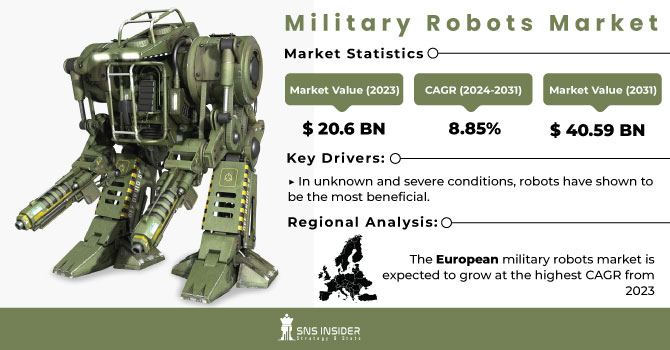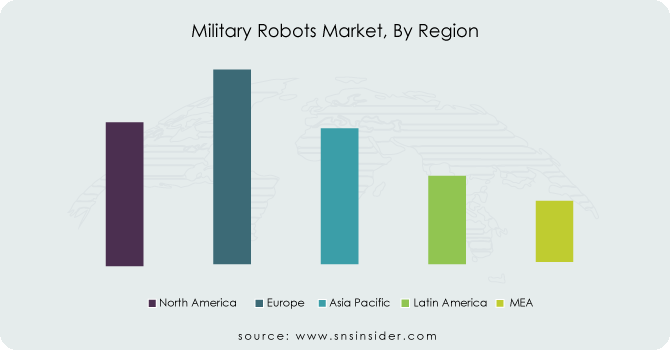Military Robots Market Report Scope & Overview:
The Military Robots Market Size was valued at USD 20.6 billion in 2023 and is expected to reach USD 40.59 billion by 2031 with a growing CAGR of 8.85% over the forecast period 2024-2031.
Military robots are remote-controlled or self-propelled robots designed for military use from transport to rescue and search operations. Some of these programs are already working, and many others are already working. Changes in the combat environment, as well as the amount placed on military losses, have supported the use of robots in recent wars. Due to the high number of casualties in previous wars, many governments have invested in new vacant systems to maintain a network of UAVs, UUVs, and UGVs of essential equipment. Countries are cooperating with advanced robot technology to build new vehicles that are able to overcome obstacles and help lower troops in future war. In addition, the major players in the industry are supported by high-cost government institutions, which allow them to spend more on R&D, allowing companies to develop more consistently and create more efficient and advanced technology.

To get more information on Military Robots Market - Request Free Sample Report
The increasing trend of connecting people with robots on the battlefield is expected to accelerate the development of unmanned weapons. Robots can perform tasks quickly and efficiently, reducing the number of casualties during combat. The installation of technologies such as artificial intelligence, real-time data monitoring, and Internet of Things in military robots has dramatically changed the evolution of modern combat. The unexpected threat posed by the military could easily be identified and tracked by AI-connected robots in the air, land and sea.
MARKET DYNAMICS
KEY DRIVERS
-
In unknown and severe conditions, robots have shown to be the most beneficial.
-
Robots for capturing images of affected areas and Rubbish removal robots
RESTRAINTS
-
Electronic jamming and electronic warfare are extremely dangerous to UAVs.
-
UAV’s can also malfunction due to weather conditions & not suitable for long-range operations.
OPPORTUNITIES
-
UGV development that is totally autonomous.
-
Defense forces' employment of these robots is intended to improve their fighting capabilities.
CHALLENGES
-
Hardware and software failures plague robots.
-
Human operators lose control of these robots, and robots occasionally miscalculate commands.
IMPACT OF COVID-19
The COVID-19 epidemic has had a multi-level impact on economies around the world. The global manufacture and production of military robot components and systems, as well as their assembly lines, are facing a moderate impact, as the supply of military robots is seen as critical for applications such as explosive ordnance disposal and mine clearing.
The number of COVID-19 positive instances and exposure a country is experiencing, the level at which manufacturing and production activities are running, the import-export rules, and other factors all have a role in resuming production, manufacturing, and delivery of military robots. Although global market enterprises may continue to accept orders, delivery timetables may not be fixed.
Fully autonomous unmanned aerial vehicles are known to be equipped with artificial intelligence and are further understood to be capable of carrying out activities with minimal human interference. The deployment of these military robots by defence forces around the world is intended to improve their fighting capabilities. The military robotics market is divided into two categories based on mode of operation: human-operated and autonomous. The autonomous category dominated the market in 2023 and is predicted to develop at a faster CAGR over the forecast period, which ends in 2031. There has been an increase in funds for research and development, as well as a significant increase in modernization initiatives, which is driving the procurement of new military equipment.
Robotics technology for military purposes is not new; it has long been used by armed forces all over the world. Military robots can perform a wide range of combat tasks, including explosive disarmament, deadly combat operations, fire support, rescue, logistics support, reconnaissance, and more. These robots can also be thought of as a replacement for human soldiers because they can handle a greater variety of combat responsibilities, such as accurately targeting enemy positions and so on. Military robots can provide support and reduce losses during severe artillery fire. They can also accurately map a potentially enormous hostile environment by identifying a range of threats. These reasons are predicted to result in rapid adoption of robotics technologies in the near future.
KEY MARKET SEGMENTATION
By End User
-
Defense
By Platform
-
Airborne Robots
-
Land Robots
-
Marine Robots
By Payload
-
Sensor
-
Radar
-
Weapon
-
Others
By Mode of Operation
-
Human Operated
-
Autonomous
By Application
-
Combat Support
-
Intelligence
-
Surveillance and Reconnaissance
-
Mine Clearance
-
Explosive Ordnance Disposal
-
Others
REGIONAL ANALYSIS
The market share of the world military robots is on the verge of a dramatic increase in the continuous forecast period that will end in 2031. The activities of the global market are divided into regions and are concentrated in 5 regions namely - North American region, APAC countries, European region, Middle East, and Africa.
The European military robots market is expected to grow at the highest CAGR from 2023 until the end of the forecast period 2031 as predicted by business executives. European regional countries such as Russia, Germany, UK, Italy, France, and All of Europe such as Sweden, Norway, Denmark, etc. are considered in this regional market analysis. The efforts they are making to grow this region internationally are commendable. One of the strong points in the growth of the military robots industry in Europe is the increased use of surveillance UAVs.

Need any customization research on Military Robots Market - Enquiry Now
REGIONAL COVERAGE:
-
North America
-
USA
-
Canada
-
Mexico
-
-
Europe
-
Germany
-
UK
-
France
-
Italy
-
Spain
-
The Netherlands
-
Rest of Europe
-
-
Asia-Pacific
-
Japan
-
south Korea
-
China
-
India
-
Australia
-
Rest of Asia-Pacific
-
-
The Middle East & Africa
-
Israel
-
UAE
-
South Africa
-
Rest of Middle East & Africa
-
-
Latin America
-
Brazil
-
Argentina
-
Rest of Latin America
-
KEY PLAYERS
The Major Players are Israel Aerospace Industries Ltd., Lockheed Martin Corporation, Rafael Advanced Defense Systems Ltd., Rheinmetall AG, SAAB AB, General Dynamics Corporation, BAE Systems plc, Elbit Systems Ltd., Northrop Grumman Corporation, Thales Group.
Lockheed Martin Corporation-Company Financial Analysis

| Report Attributes | Details |
|---|---|
| Market Size in 2023 | US$ 20.6 Billion |
| Market Size by 2031 | US$ 40.59 Billion |
| CAGR | CAGR of 8.85% From 2024 to 2031 |
| Base Year | 2023 |
| Forecast Period | 2024-2031 |
| Historical Data | 2020-2022 |
| Report Scope & Coverage | Market Size, Segments Analysis, Competitive Landscape, Regional Analysis, DROC & SWOT Analysis, Forecast Outlook |
| Key Segments | • By End User (Defense, Homeland Security) • By Platform (Airborne Robots, Land Robots, and Marine Robots) • By Payload (Sensor, Radar, Weapon, and Others) • By Mode of Operation (Human Operated and Autonomous) • By Application (Combat Support, Intelligence, Surveillance and Reconnaissance, Mine Clearance, Explosive Ordnance Disposal, and Others) |
| Regional Analysis/Coverage | North America (USA, Canada, Mexico), Europe (Germany, UK, France, Italy, Spain, Netherlands, Rest of Europe), Asia-Pacific (Japan, South Korea, China, India, Australia, Rest of Asia-Pacific), The Middle East & Africa (Israel, UAE, South Africa, Rest of Middle East & Africa), Latin America (Brazil, Argentina, Rest of Latin America) |
| Company Profiles | Israel Aerospace Industries Ltd., Lockheed Martin Corporation, Rafael Advanced Defense Systems Ltd., Rheinmetall AG, SAAB AB, General Dynamics Corporation, BAE Systems plc, Elbit Systems Ltd., Northrop Grumman Corporation, Thales Group. |
| DRIVERS | • In unknown and severe conditions, robots have shown to be the most beneficial. • Robots for capturing images of affected areas and Rubbish removal robots |
| RESTRAINTS | • Electronic jamming and electronic warfare are extremely dangerous to UAVs. • UAV’s can also malfunction due to weather conditions & not suitable for long-range operations. |

